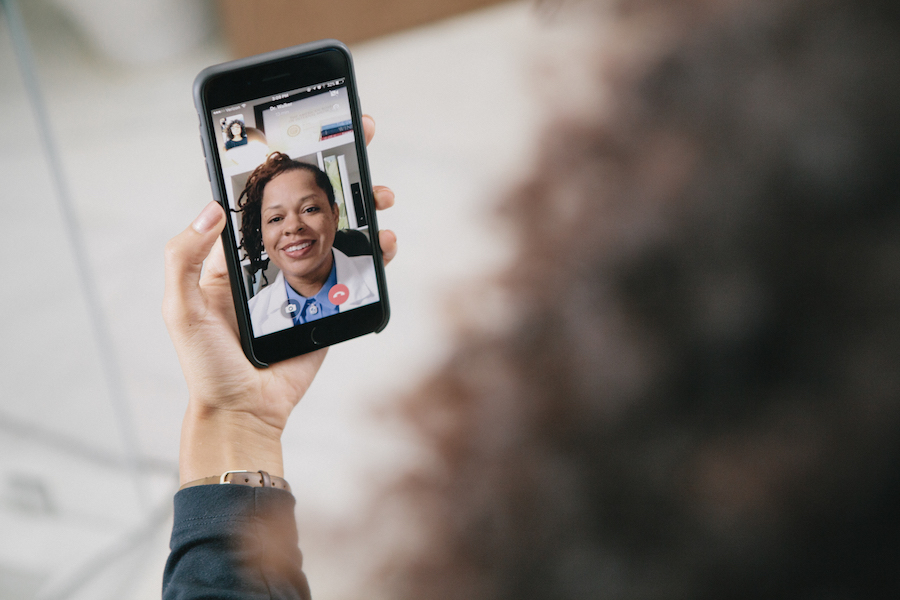Healthcare / Innovation
Comment
The patient is becoming the point of care – enter telemedicine 2.0
05 Oct 2020 | 0
In this extract from a wider article entitled ‘The future of healthcare’, published in WSP’s ‘The Possible’ magazine, Katie Puckett explores the role of telehealth and remote monitoring in providing access for patients and delivering care.
Telehealth has been one of the fastest growing parts of the healthcare sector, with a range of new apps and devices to serve a patient base that is increasingly tech savvy. The millennial generation and younger, in particular, are comfortable with digital interaction and demanding that providers allow them to access services in this way.
For patients, the prospect of video consultations with clinicians is more convenient than taking time to go to the hospital, especially for routine check-ups or minor conditions. For providers, helping patients to better manage conditions at home through remote monitoring and automated reminders offers a way to reduce the burden of chronic disease and demand for medical intervention. The COVID-19 pandemic has accelerated this trend, as governments around the world urge their citizens to stay at home, and for only the most severe cases to attend hospitals. 
“Telemedicine will be a critically important access point,” says Michael Crawford, associate dean for strategy, outreach and innovation at Howard University College of Medicine in Washington DC. “It’s not only how we leverage telemedicine and remote monitoring in a pandemic, it’s how we should deliver care, period.”
Data will be the key to future medicine, he believes. By integrating health, social, financial and environmental data across disparate platforms and applying artificial intelligence and machine learning, we will be able to better track infectious disease or flag patients at risk.
“If people have been instructed to self-quarantine for 14 days, we could evaluate them based on historical data and start to create personalised, real-time interventions. If an individual’s biometrics deviate from the normal pattern of recovery, we could proactively deploy resources to address the issue.”
The only way to deliver care to people in their homes is to understand how they function within their home environment – their natural habitat, he adds.
“If we’re capturing a patient’s activity patterns and evaluating their heart rate, blood pressure, breathing patterns, sleeping levels from a wearable device or sensor, then we can observe if they’re trending in the right direction or when a medical intervention would be appropriate.” Patients could be sent a message to check in or, in more serious cases, a medical professional sent to their home.
The most important thing is the quality of the data, says Crawford. “If you have an integrated historical data set, collecting new information provides different insights regarding an individual’s health and enables you to personalise interventions. If we had this infrastructure in place today, we could be more efficient, strategic and prudent in our resource allocation in addressing a pandemic.”
But – and it’s a big one – telehealth’s potential will only be realised if it’s targeted at the populations that have the greatest incidence of chronic disease: “When we’re referring to vulnerable patients that are susceptible to COVID-19, a disproportionate amount reside in medically underserved communities.” These are exactly the communities that find themselves on the wrong side of the digital divide, lacking the resources and technical literacy to fully participate online.
Howard University is seeking to address this with its 1867 Health Innovations project – Crawford is inviting tech entrepreneurs, innovators and corporate partners to develop scalable models for this demographic over the coming months. Solutions are likely to be delivered over cell phones, but Crawford expects them to depart from existing products in various ways.
“The clinical pilots will likely reveal that minor modifications in content, interfaces and tech that better align with individuals’ care needs,” he says. “The interface might look different, the content might be worded differently, the instructions and manual might look different, the things that you have prioritised might look different for a chronically ill population.”
When super-fast 5G networks, high-definition video conferencing, and ubiquitous sensors are a reality, it will also radically reshape the healthcare landscape. Outpatient clinics are likely to become a thing of the past and only the most serious conditions will necessitate a trip to hospital.
“Historically, hospital visitors have been a mix of the semi-sick to those with really serious illnesses,” says Jason Schroer at HKS. “We’re seeing a slow shift to the hospital becoming a place for only the sickest of the sick.”
This article forms part of a broader feature called ‘The future of healthcare’, in WSP’s own magazine ‘The Possible’. The feature covers a range of issues including: healthcare spending; demographic trends; the growth of medtech; a case study and interview with Cleveland Clinic; universal healthcare access in Africa; resilience planning against external threats, such as COVID-19; and how healthy cities can support the preventive health agenda.
Organisations involved

